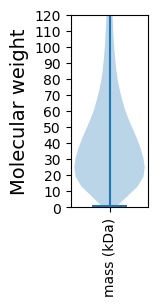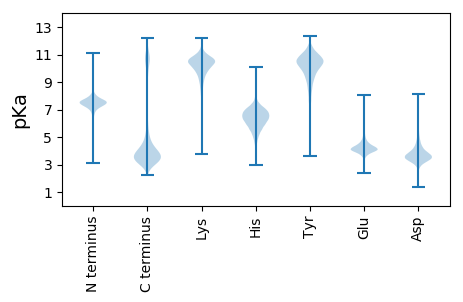
Dinothrombium tinctorium
Taxonomy: cellular organisms; Eukaryota; Opisthokonta; Metazoa; Eumetazoa; Bilateria; Protostomia; Ecdysozoa; Panarthropoda; Arthropoda; Chelicerata; Arachnida; Acari; Acariformes; Trombidiformes; Prostigmata; Anystina; Parasitengona; Trombidioidea; Trombidiidae; Dinothrombium
Average proteome isoelectric point is 6.81
Get precalculated fractions of proteins

Virtual 2D-PAGE plot for 13518 proteins (isoelectric point calculated using IPC2_protein)
Get csv file with sequences according to given criteria:
* You can choose from 21 different methods for calculating isoelectric point
Summary statistics related to proteome-wise predictions



Protein with the lowest isoelectric point:
>tr|A0A3S3P0X2|A0A3S3P0X2_9ACAR Protein lin-9-like protein OS=Dinothrombium tinctorium OX=1965070 GN=B4U79_00973 PE=3 SV=1
MM1 pKa = 7.35ATMDD5 pKa = 4.44SSGGDD10 pKa = 3.12NDD12 pKa = 3.43VSPFLDD18 pKa = 4.41EE19 pKa = 4.23ILLNKK24 pKa = 10.13SVTIRR29 pKa = 11.84PDD31 pKa = 3.3DD32 pKa = 3.93VNATNDD38 pKa = 3.7YY39 pKa = 10.51NWIFLFLIAFIFIGIVGNVLVCLAICLEE67 pKa = 4.0RR68 pKa = 11.84RR69 pKa = 11.84LQNATNYY76 pKa = 9.84FLLSLAVADD85 pKa = 4.48LLVCVVVMPILILDD99 pKa = 3.98DD100 pKa = 5.47FYY102 pKa = 11.93ACKK105 pKa = 10.42
MM1 pKa = 7.35ATMDD5 pKa = 4.44SSGGDD10 pKa = 3.12NDD12 pKa = 3.43VSPFLDD18 pKa = 4.41EE19 pKa = 4.23ILLNKK24 pKa = 10.13SVTIRR29 pKa = 11.84PDD31 pKa = 3.3DD32 pKa = 3.93VNATNDD38 pKa = 3.7YY39 pKa = 10.51NWIFLFLIAFIFIGIVGNVLVCLAICLEE67 pKa = 4.0RR68 pKa = 11.84RR69 pKa = 11.84LQNATNYY76 pKa = 9.84FLLSLAVADD85 pKa = 4.48LLVCVVVMPILILDD99 pKa = 3.98DD100 pKa = 5.47FYY102 pKa = 11.93ACKK105 pKa = 10.42
Molecular weight: 11.67 kDa
Isoelectric point according different methods:
Protein with the highest isoelectric point:
>tr|A0A3S3NPG7|A0A3S3NPG7_9ACAR Tetraspanin OS=Dinothrombium tinctorium OX=1965070 GN=B4U79_05050 PE=3 SV=1
II1 pKa = 7.0SARR4 pKa = 11.84TRR6 pKa = 11.84ISARR10 pKa = 11.84TSISTKK16 pKa = 8.45TRR18 pKa = 11.84ISSIARR24 pKa = 11.84ISTRR28 pKa = 11.84TRR30 pKa = 11.84IFYY33 pKa = 7.74RR34 pKa = 11.84TRR36 pKa = 11.84ISSRR40 pKa = 11.84TRR42 pKa = 11.84ISARR46 pKa = 11.84TRR48 pKa = 11.84ISARR52 pKa = 11.84TNISTKK58 pKa = 8.57TRR60 pKa = 11.84ISSIARR66 pKa = 11.84ISTRR70 pKa = 11.84TRR72 pKa = 11.84IFYY75 pKa = 7.75RR76 pKa = 11.84TRR78 pKa = 11.84ILYY81 pKa = 9.97RR82 pKa = 11.84SRR84 pKa = 11.84SSSRR88 pKa = 11.84NRR90 pKa = 11.84ISTSSRR96 pKa = 11.84ISIRR100 pKa = 11.84FRR102 pKa = 11.84IFYY105 pKa = 9.89RR106 pKa = 11.84SPNSIVII113 pKa = 3.83
II1 pKa = 7.0SARR4 pKa = 11.84TRR6 pKa = 11.84ISARR10 pKa = 11.84TSISTKK16 pKa = 8.45TRR18 pKa = 11.84ISSIARR24 pKa = 11.84ISTRR28 pKa = 11.84TRR30 pKa = 11.84IFYY33 pKa = 7.74RR34 pKa = 11.84TRR36 pKa = 11.84ISSRR40 pKa = 11.84TRR42 pKa = 11.84ISARR46 pKa = 11.84TRR48 pKa = 11.84ISARR52 pKa = 11.84TNISTKK58 pKa = 8.57TRR60 pKa = 11.84ISSIARR66 pKa = 11.84ISTRR70 pKa = 11.84TRR72 pKa = 11.84IFYY75 pKa = 7.75RR76 pKa = 11.84TRR78 pKa = 11.84ILYY81 pKa = 9.97RR82 pKa = 11.84SRR84 pKa = 11.84SSSRR88 pKa = 11.84NRR90 pKa = 11.84ISTSSRR96 pKa = 11.84ISIRR100 pKa = 11.84FRR102 pKa = 11.84IFYY105 pKa = 9.89RR106 pKa = 11.84SPNSIVII113 pKa = 3.83
Molecular weight: 13.25 kDa
Isoelectric point according different methods:
Peptides (in silico digests for buttom-up proteomics)
Below you can find in silico digests of the whole proteome with Trypsin, Chymotrypsin, Trypsin+LysC, LysN, ArgC proteases suitable for different mass spec machines.| Try ESI |
 |
|---|
| ChTry ESI |
 |
|---|
| ArgC ESI |
 |
|---|
| LysN ESI |
 |
|---|
| TryLysC ESI |
 |
|---|
| Try MALDI |
 |
|---|
| ChTry MALDI |
 |
|---|
| ArgC MALDI |
 |
|---|
| LysN MALDI |
 |
|---|
| TryLysC MALDI |
 |
|---|
| Try LTQ |
 |
|---|
| ChTry LTQ |
 |
|---|
| ArgC LTQ |
 |
|---|
| LysN LTQ |
 |
|---|
| TryLysC LTQ |
 |
|---|
| Try MSlow |
 |
|---|
| ChTry MSlow |
 |
|---|
| ArgC MSlow |
 |
|---|
| LysN MSlow |
 |
|---|
| TryLysC MSlow |
 |
|---|
| Try MShigh |
 |
|---|
| ChTry MShigh |
 |
|---|
| ArgC MShigh |
 |
|---|
| LysN MShigh |
 |
|---|
| TryLysC MShigh |
 |
|---|
General Statistics
Number of major isoforms |
Number of additional isoforms |
Number of all proteins |
Number of amino acids |
Min. Seq. Length |
Max. Seq. Length |
Avg. Seq. Length |
Avg. Mol. Weight |
|---|---|---|---|---|---|---|---|
0 |
5891483 |
8 |
5318 |
435.8 |
49.46 |
Amino acid frequency
Ala |
Cys |
Asp |
Glu |
Phe |
Gly |
His |
Ile |
Lys |
Leu |
|---|---|---|---|---|---|---|---|---|---|
5.755 ± 0.017 | 2.15 ± 0.016 |
5.223 ± 0.014 | 6.791 ± 0.024 |
4.776 ± 0.019 | 4.877 ± 0.021 |
2.299 ± 0.01 | 6.7 ± 0.019 |
7.164 ± 0.021 | 9.269 ± 0.028 |
Met |
Asn |
Gln |
Pro |
Arg |
Ser |
Thr |
Val |
Trp |
Tyr |
|---|---|---|---|---|---|---|---|---|---|
2.079 ± 0.007 | 5.796 ± 0.017 |
4.285 ± 0.022 | 3.839 ± 0.016 |
4.87 ± 0.015 | 8.394 ± 0.027 |
5.312 ± 0.015 | 5.944 ± 0.017 |
1.094 ± 0.006 | 3.367 ± 0.012 |
Most of the basic statistics you can see at this page can be downloaded from this CSV file
Proteome-pI is available under Creative Commons Attribution-NoDerivs license, for more details see here
| Reference: Kozlowski LP. Proteome-pI 2.0: Proteome Isoelectric Point Database Update. Nucleic Acids Res. 2021, doi: 10.1093/nar/gkab944 | Contact: Lukasz P. Kozlowski |
